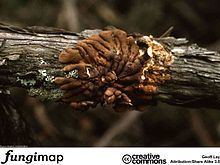Kingdom Fungi | Rank Species | |
 | ||
Similar Hypocreopsis, Hypocreopsis rhododendri, Hypocreales, Hypocreaceae, Hypocrea | ||
Hypocreopsis amplectens is part of the family Hypocreaceae and genus Hypocreopsis, fungi that form stromata on the stems of trees and shrubs. The stromata are orange-brown and consist of radiating, perithecial lobes. This species of Hypocreopsis was only discovered in 1992 in Nyora (Victoria) during a survey of vascular plants.
Contents
Description
Found on dead and living branches of tea-tree, paperbark and banksia in long-unburnt coastal stands in Victoria. This firm-textured, brown, irregularly shaped species forms a raised mass which clasps dead branches with light brown, finger-like lobes.
Most commonly dead branches of prickly tea-tree (Leptospermum continentale), silky tea-tree (L. myrsinoides) and silver banksia (Banksia marginata). It has also been found on dead and living scented paperbark (Melaleuca squarrosa). The immediate substrate is a Brown Paint Fungus.
Fruit body length to 60 mm; a raised mass, strongly lobed; margin irregular. Lobes to 10 mm wide, clasping substrate; brown, tips of lobes paler yellowish-brown; older specimens often have white, powdery areas.
Taxonomy
This species of Hypocreopsis was only discovered in 1992 in Nyora (Victoria) during a survey of vascular plants. This fungus has previously been referred to as Hypocreopsis sp. and Hypocreopsis sp. ‘Nyora’ in the Australian literature. In Victoria, H. amplectens has been classified as "vulnerable" under the Victorian Flora and Fauna Guarantee Act 1988, and the Nyora Flora and Fauna Reserve was created partly because of its occurrence there. Despite intensive surveys it is still known from only three sites in Australia, making it a rare fungus eligible for inclusion on national threat status lists in Australia and New Zealand.
